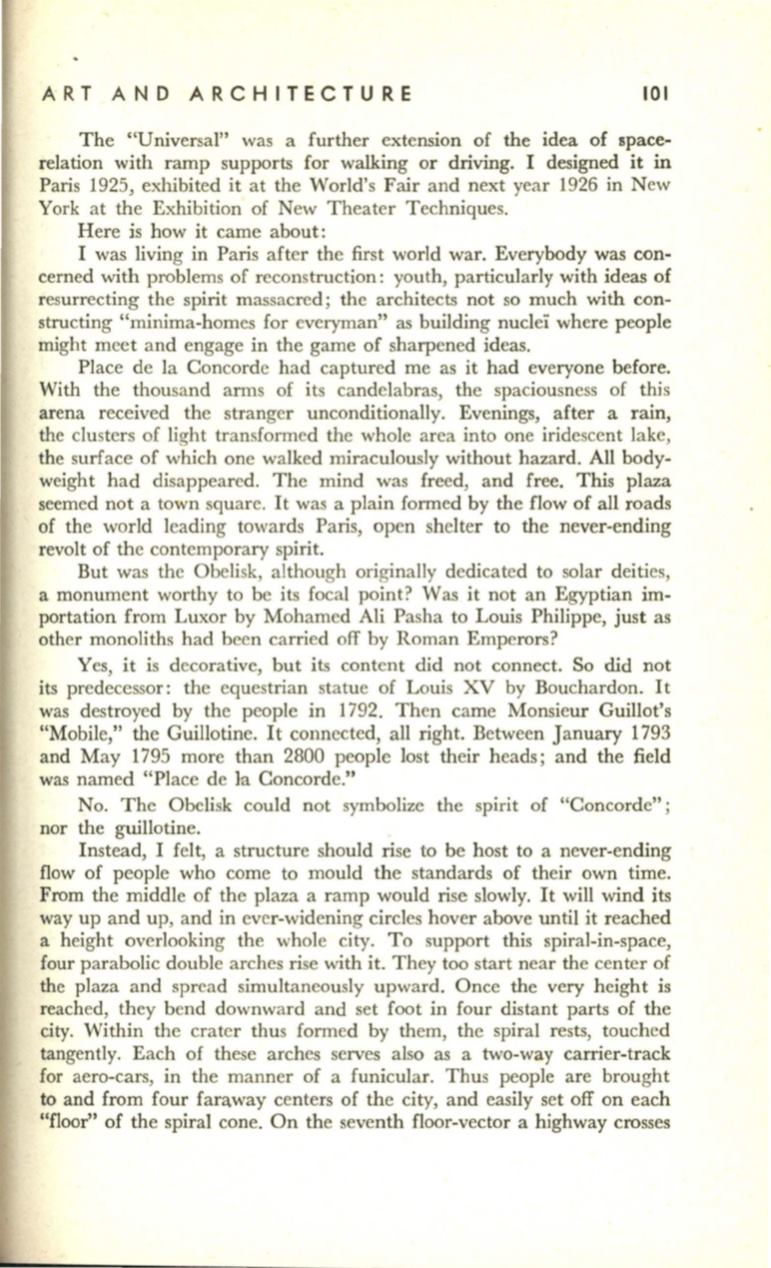
ART AND ARCHITECTURE
101
The "Universal" was a further extension of the idea of space–
relation with ramp supports for walking or driving. I designed it
in
Paris 1925, exhibited it at the World's Fair and next year 1926 in New
York at the Exhibition of New Theater Techniques.
Here is how it came about:
I was living in Paris after the first world war. Everybody was con–
cerned with problems of reconstruction: youth, particularly with ideas of
resurrecting the spirit massacred; the architects not so much with con–
structing "minima-homes for everyman" as building nuclei where people
might meet and engage in the game of sharpened ideas.
Place de la Concorde had captured me as it had everyone before.
With the thousand arms of its candelabras, the spaciousness of this
arena received the stranger unconditionally. Evenings, after a rain,
the clusters of light transformed the whole area into one iridescent lake,
the surface of which one walked miraculously without hazard. All body–
weight had disappeared. The mind was freed, and free. This plaza
seemed not a town square. It was a plain formed by the flow of all roads
of the world leading towards Paris, open shelter to the never-ending
revolt of the contemporary spirit.
But was the Obelisk, although originally dedicated to solar deities,
a monument worthy to be its focal point? Was it not an Egyptian im–
portation from Luxor by Mohamed Ali Pasha to Louis Philippe, just as
other monoliths had been carried off by Roman Emperors?
Yes, it is decorative, but its content did not connect. So did not
its predecessor: the equestrian statue of Louis XV by Bouchardon.
It
was destroyed by the people in 1792. Then came Monsieur Guillot's
"Mobile," the Guillotine. It connected, all right. Between January 1793
and May 1795 more than 2800 people lost their heads; and the field
was named "Place de la Concorde."
No. The Obelisk could not symbolize the spirit of "Concorde";
nor the guillotine.
Instead, I felt, a structure should rise to be host to a never-ending
flow of people who come to mould the standards of their own time.
From the middle of the plaza a ramp would rise slowly. It will wind its
way up and up, and in ever-widening circles hover above until it reached
a height overlooking the whole city. To support this spiral-in-space,
four parabolic double arches rise with it. They too start near the center of
the plaza and spread simultaneously upward. Once the very height is
reached, they bend downward and set foot in four distant parts of the
city. Within the crater thus formed by them, the spiral rests, touched
tangently. Each of these arches serves also as a two-way carrier-track
for aero-cars, in the manner of a funicular. Thus people are brought
to and from four fara,way centers of the city, and easily set off on each
"floor" of the spiral cone. On the seventh floor-vector a highway crosses


